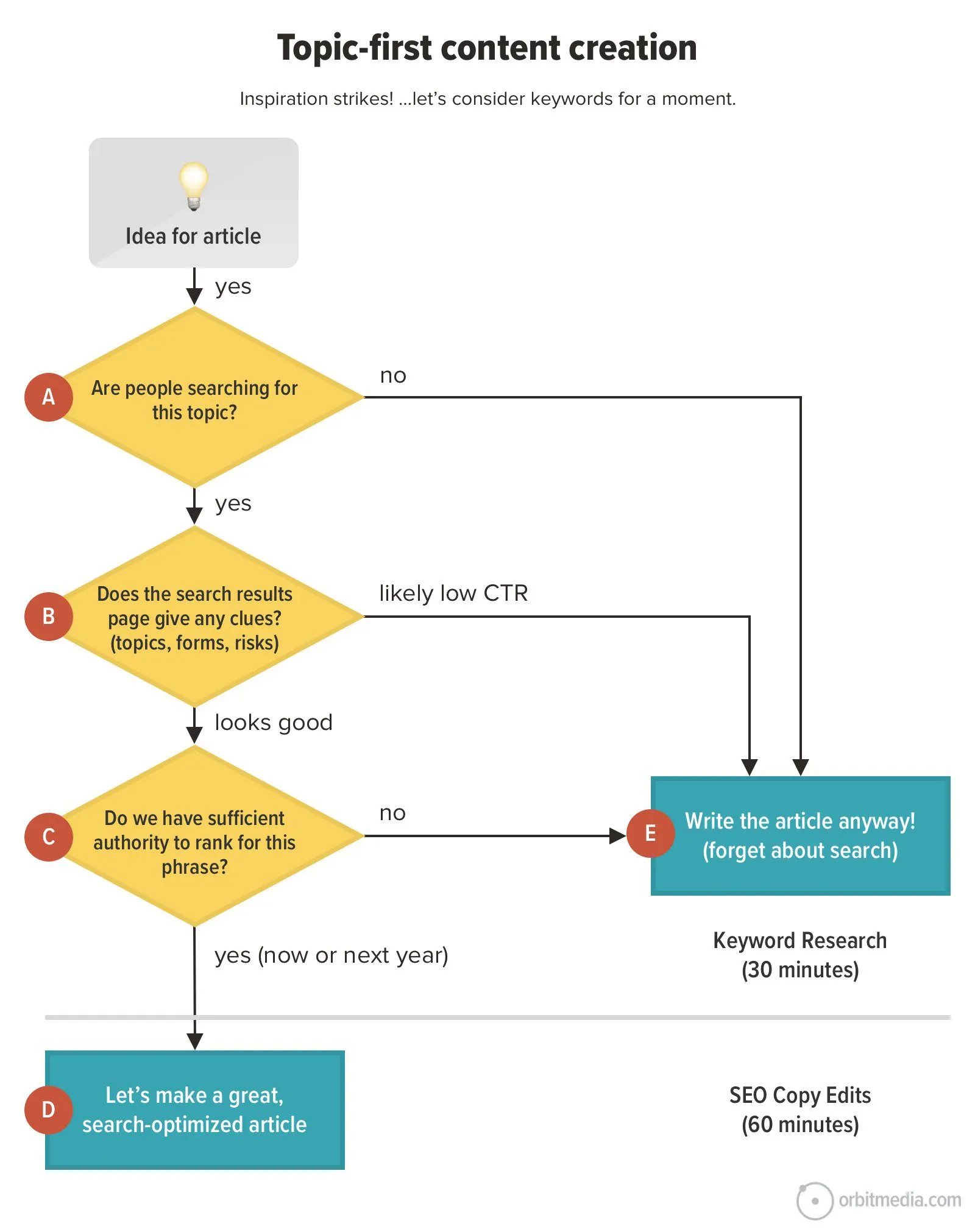Topic-first SEO for agencies: Complete guide + 2 ready-to-use prompts

Stop chasing individual keywords and start building topical authority that actually lasts. Here’s how to shift your client work from volume-driven content to comprehensive topic coverage.
You’ve probably heard the advice: “Keywords are dead, topics are the future.” But what does that actually mean for your agency? And more importantly, how do you implement topic-first SEO for clients without completely overhauling your existing processes?
The shift isn’t about abandoning keywords entirely—it’s about changing how you decide what content to create. Instead of only writing when there’s search volume, you’re building comprehensive topic coverage that positions your clients as the go-to authority in their space.
What topic-first SEO actually means
Topic-first SEO is about optimizing around broader subject areas that encompass multiple related keywords, user questions, and search intents. Instead of targeting individual phrases, you’re creating content ecosystems that thoroughly address everything users need to know about a topic.
The key difference: With keyword-first SEO, you only create content if there’s measurable search volume. With topic-first SEO, you create content to fill topical gaps—even if those specific pieces won’t rank or drive traditional organic traffic.
Structurally this concept isn’t that different from hub-and-spoke or pillar content models you might already use. You still have main pillar pages with supporting cluster content linking back to them. The difference is in your content decisions: you’re prioritizing comprehensive coverage over search volume metrics.
Why algorithms are rewarding topic-first approaches
Search engines have evolved beyond simple keyword matching. Google’s algorithm now evaluates topical relevance, semantic relationships, and how thoroughly a site covers subject areas. When you demonstrate deep expertise across an entire topic, you’re more likely to rank for both your target keywords and related long-tail variations.
This matters even more as AI search features become prominent. Large language models evaluate content for comprehensiveness and authority—they reward sites that can answer the full spectrum of questions within a topic area, not just the highest-volume keywords.
The practical impact: A client with thorough topic coverage often outranks sites that only target high-volume keywords, because they satisfy more user intents and demonstrate genuine expertise.
Traditional SEO vs. topic-first: What changes
Keyword-first approach:
- Content creation driven by search volume data
- Focus on individual keyword targets per page
- Success measured by rankings for specific phrases
- Content gaps ignored if no volume data exists
- Risk of thin, keyword-stuffed content
Topic-first approach:
- Content creation driven by user needs and topical completeness
- Focus on comprehensive subject coverage
- Success measured by overall topic authority and user satisfaction
- Content created to fill knowledge gaps regardless of search volume
- Results in deeper, more useful content ecosystems
The structural framework remains similar—you’re still creating pillar content with supporting cluster pages. But your editorial decisions shift from “Is this keyword worth targeting?” to “Does this content help us become the definitive resource on this topic?”
Andy Crestodina breaks down this distinction perfectly (and hilariously) in his analysis of keyword-first versus topic-first content development:

How to identify your clients’ core topics
Start by mapping your client’s expertise areas and business focus. Topics should be broad enough to support multiple pieces of content but specific enough to demonstrate clear authority.
For a sustainable home design firm:
- Core topics might include: sustainable interior design, eco-friendly building materials, zero-waste living, green home upgrades
- Each topic supports dozens of subtopics and user questions
- Content addresses different user types: homeowners, builders, property managers
For a B2B software company:
- Core topics might align with product categories and use cases
- Each topic covers implementation, best practices, troubleshooting, industry-specific applications
- Content serves different roles in the buying journey
The goal is identifying 5-10 core topics that your client can authentically claim expertise in and that support their business objectives.
Using MetaMonster for topic-first analysis
MetaMonster’s chat agent includes specialized prompts for analyzing your clients’ current topic coverage and identifying gaps. Here’s how to use them:
Step 1: Analyze existing topic clusters
After crawling your client’s site in MetaMonster, use this prompt in the chat agent:
[Topic analysis](https://metamonster.ai/prompt-library/topic-analysis/) 🚧
You are a topical SEO expert analyzing website content for user-focused topic clusters and authority. Using the content cluster analysis results, identify which clusters represent genuine SEO topics versus operational content, then concisely map out only the legitimate topic clusters.
**CONTEXT:**
- **Topics** are high-level, user-focused themes that represent broad user needs or areas of expertise (e.g., "Ranking in AI Search" or "How to do an SEO audit")
- **Individual keywords** are supporting elements, but topics are the foundation of organic authority
- **Not all content clusters are topics** - many clusters contain product pages, navigation, company info, or operational content that don't represent topical authority opportunities
**CLUSTER FILTERING CRITERIA:**
Before analyzing clusters as topics, exclude clusters that are primarily:
- Product/service landing pages without educational depth
- Navigation elements, footers, or site structure pages
- Company information, about pages, or contact forms
- Event pages, registration forms, or promotional content
- Technical/legal pages (privacy policies, terms, etc.)
- Single-page clusters without supporting content depth
**TOPIC IDENTIFICATION CRITERIA:**
Only analyze clusters as topics if they contain:
- Educational or informational content that serves user needs
- Multiple pages addressing different aspects of a broader subject
- Content that demonstrates expertise in a specific domain
- Pages that could logically support a pillar-cluster content strategy
**ANALYSIS FRAMEWORK:**
For each legitimate topic cluster identified, analyze:
- **Core pillar content** (comprehensive, authoritative pieces)
- **Supporting cluster content** (specific subtopics and related questions)
- **Content gaps within clusters** (missing subtopics that users expect)
**OUTPUT FORMAT:**
Start with a brief summary: "Found [X] legitimate topic clusters out of [Y] total content clusters analyzed."
Then present findings in a CSV file with the following columns:
- **Topic Cluster Name**
- Pillar page: [link to ideal pillar page or proposal for a pillar page]
- Subtopics: [key subtopics covered]
- Depth analysis: [concise analysis of coverage depth]
- Gaps: [missing subtopics within this cluster]
- Pages: [list of pages that fit this topic]
**If no legitimate topics found:** "No substantial topic clusters identified. The analyzed clusters primarily contain [brief description of what was found - product pages, navigation, etc.]. Consider creating pillar content around [suggest 2-3 potential topics based on business context]."
Please analyze the content clusters and identify only those that represent genuine topical SEO opportunities. Be concise.
This analysis shows you what topics your client already covers and how thoroughly they address each subject area.
Step 2: Identify topic gaps and opportunities
Use this second prompt to find missing topics that could strengthen your client’s authority:
[Topic gap analysis](https://metamonster.ai/prompt-library/topic-gap-analysis/) 🚧
You are a topical SEO strategist identifying topic gaps and expansion opportunities. Based on my existing site content, identify missing user-focused topics that would strengthen my topical authority and increase organic search traffic. Be concise.
**CONTEXT:**
An **SEO topic** is a broader subject area or theme that encompasses multiple related keywords, user questions, and search intents around a central concept.
**Key characteristics of an SEO topic:**
**Scope**: Broader than individual keywords - it's a conceptual umbrella that covers related search queries and user needs
**User-focused**: Represents what users are trying to learn about or accomplish, not just search volume opportunities
**Semantic depth**: Includes the full range of questions, problems, and information needs within that subject area
**Content potential**: Can support multiple pieces of content (pillar content + supporting cluster content)
**Search engine alignment**: Matches how modern search algorithms understand topical relevance and semantic relationships
**Examples:**
- **Topic**: "Email Marketing"
- *Keywords within this topic*: email marketing software, automation workflows, template design, deliverability optimization, list building, A/B testing, etc.
- **Topic**: "Local SEO"
- *Keywords within this topic*: Google Business Profile optimization, local citations, review management, local keyword research, NAP consistency, etc.
**Why topics matter more than keywords:**
- Search engines reward comprehensive topic coverage over keyword stuffing
- Users prefer sites that thoroughly address their subject area
- Topics create natural [internal linking opportunities](https://metamonster.ai/prompt-library/internal-link-suggestions/)
- They align with how people actually search (conversational, intent-based)
- They build long-term authority rather than short-term rankings
In essence, an SEO topic is about becoming the go-to resource for everything related to a subject, rather than just answering isolated search queries.
**OUTPUT FORMAT:**
```markdown
## Topic
- Keywords: [List of keywords]
- Why: [Brief description of why this topic is a good fit]
This identifies opportunities to expand into adjacent topics that strengthen overall authority and capture additional search demand.
Building your topic-first content strategy
Once you’ve analyzed existing coverage and identified gaps, create a content roadmap that prioritizes:
- Filling gaps in existing topics - Complete your current topic clusters before expanding
- Creating pillar content - Comprehensive guides that anchor each topic
- Developing supporting content - Specific subtopics, user questions, and edge cases
- Cross-topic connections - Content that bridges related topics and creates internal linking opportunities
Remember: Not every piece needs to target high-volume keywords. Some content exists purely to demonstrate expertise, answer user questions, or provide context that strengthens your client’s overall authority.
And if you want to take this even further, Kevin Indig and Amanda Johnson provide a SUPER detailed implementation framework for building topic-first workflows across a large content catalogue with multiple personas.
Measuring topic-first success
Traditional metrics like individual keyword rankings become less important with a topic-first approach. Instead, track:
- Topic-level visibility - How many related keywords does your client rank for across the entire topic?
- Content engagement - Time on page, internal link clicks, and user journeys across topic clusters
- Authority signals - Backlinks to topic content, mentions as a resource, featured snippets across topic keywords
- Business impact - Qualified leads and conversions from topic-driven content
Once you have your topic map use MetaMonster to quickly categorize content by topic and then feed that into your other tools to track performance at the cluster level rather than individual pages.
Getting started with your current clients
You don’t need to rebuild everything at once. Start by:
- Audit one core topic area using the MetaMonster prompts above
- Identify 2-3 quick wins - missing subtopics you can create without major research
- Fill the gaps with focused content that demonstrates deeper expertise
- Monitor topic-level improvements in rankings and engagement
- Expand to additional topics once you see positive results
The shift to topic-first SEO isn’t about abandoning everything you know—it’s about making more holistic content decisions that build lasting authority instead of chasing individual keyword opportunities.
Your clients will appreciate the comprehensive approach, and you’ll see more sustainable results that survive algorithm changes and shifting search behaviors. This approach is particularly valuable for AI search optimization, where comprehensive topic coverage helps position clients for visibility in AI overviews and LLM citations.
Ready to start building topical authority for your clients? Use these topic analysis prompts in the MetaMonster SEO chat agent to see exactly where their content stands and what opportunities you’re missing!
Drowning in client work but unwilling to compromise on quality?
Automate the grunt work with MetaMonster. Your first 500 credits are free. Crawl your first site to see how MetaMonster can transform your workflows.